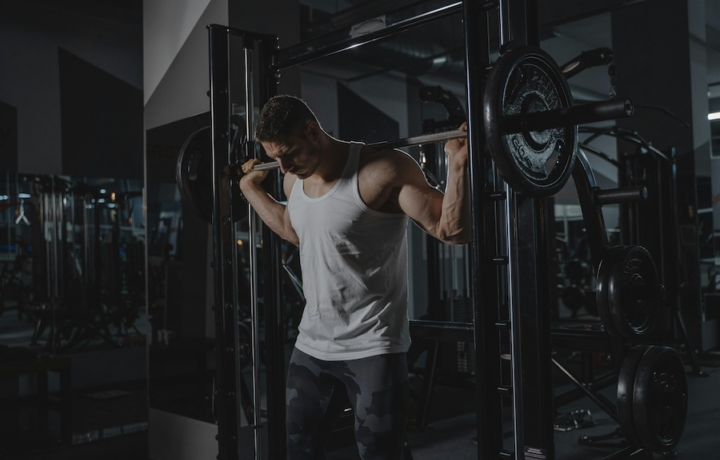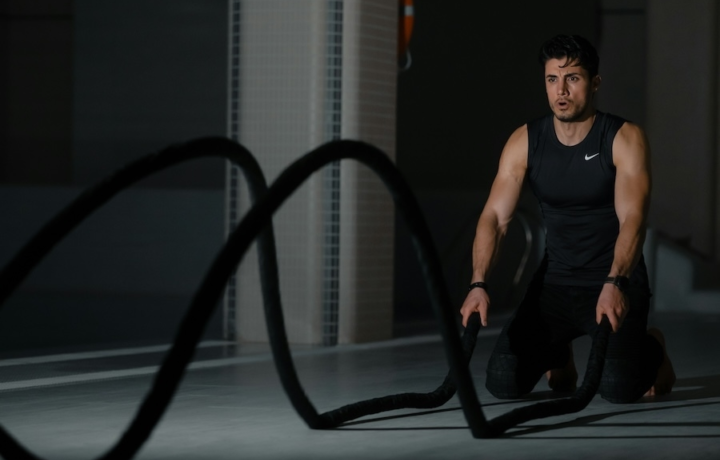Exercise
Dumbbell Step Up

Dumbbell Step Up
How to Perform
- Stand in front of a stable bench or platform holding dumbbells at your sides with palms facing inward and maintain a neutral spine position. Engage your core muscles before initiating movement.
- Place your entire right foot on the platform, ensuring your foot is flat and centered for stability. Keep your chest up and shoulders pulled back.
- Press through your right heel and extend your right leg to lift your body up onto the platform. Exhale during this exertion phase.
- As you step up, maintain an upright torso position and avoid leaning forward excessively. Keep your knee tracking in line with your toes.
- Bring your left foot completely onto the platform beside your right foot, achieving a standing position. Maintain tension in your core throughout this transition.
- Shift your weight back to your right leg and begin lowering by stepping your left foot back to the starting position. Inhale during this lowering phase.
- Control the descent by engaging your right quadriceps and glutes as you lower your body. Keep your torso upright and avoid rushing the movement.
- Once your left foot reaches the floor, follow with your right foot to return to the starting position, keeping the dumbbells steady at your sides. Repeat for the prescribed repetitions before switching lead legs.
Important information
- Choose a platform height that allows your knee to bend at approximately 90 degrees when your foot is placed on top.
- Keep your gaze forward throughout the exercise to maintain proper spine alignment and prevent rounding of the upper back.
- Drive through your heel rather than your toes to properly engage the posterior chain muscles.
- If balance is an issue, try performing the exercise first without weights until you master the movement pattern.

Dumbbell Step Up
Exercise Details
Primary Muscles
Muscle Groups
Mechanic
Risk Areas
Built for progress
Take the guesswork out of training
Create personalized AI-powered workout plans that evolve with you. Train smarter, track every rep and keep moving forward, one workout at a time.






The Dumbbell Step Up stands as an incredibly versatile compound movement that delivers remarkable lower body development while challenging your cardiovascular system. This intermediate-level exercise primarily targets the glutes, quads, and hamstrings, making it a powerhouse movement for anyone looking to build lower body strength and definition.
When incorporated into various training styles like HIIT, bodybuilding, or CrossFit, the Dumbbell Step Up adapts seamlessly to different programming goals. In HIIT workouts, it elevates heart rate quickly while maintaining resistance benefits. For bodybuilders, it offers targeted muscle activation and hypertrophy potential, especially when performed with heavier weights and controlled tempo. CrossFit enthusiasts appreciate its functional carryover to everyday movements and athletic performance.
What sets the Dumbbell Step Up apart is its dual focus on developing both strength and endurance simultaneously. The unilateral nature of the exercise creates greater stability challenges than bilateral movements, enhancing proprioception and addressing muscle imbalances between sides. This translates to more balanced physical development and reduced injury risk over time.
Another advantage is the exercise's scalability – it can be modified by adjusting step height, dumbbell weight, or rep schemes to match your current fitness level and goals. This adaptability makes it valuable for progressive overload principles, allowing continuous advancement without plateauing.
The Dumbbell Step Up also delivers significant metabolic benefits, burning substantial calories during and after your workout through the EPOC effect (Excess Post-exercise Oxygen Consumption). This makes it particularly effective for body composition goals when combined with proper nutrition.
For optimal integration into your routine, consider placing Dumbbell Step Ups early in your workout when targeting strength development or later when pursuing endurance adaptations. Either way, this exercise delivers exceptional results for lower body development while supporting functional movement patterns that transfer to daily activities and athletic performance.
FAQ - Dumbbell Step Up
Dumbbell Step Ups primarily target your quadriceps, glutes, and hamstrings, while also engaging your calves and core muscles for stabilization. The unilateral nature of this exercise helps identify and correct muscle imbalances between your left and right sides.
Modify the challenge by changing the step height (lower for beginners, higher for advanced), adjusting dumbbell weight, or altering your tempo (slow eccentric phase for greater muscle tension). For an advanced variation, add a knee drive at the top of the movement to further engage your core and hip flexors.
The most common errors include pushing off with the trailing leg (instead of driving through the heel of the working leg), leaning too far forward, rushing the movement, or using momentum rather than controlled strength. Always maintain an upright torso and ensure your knee tracks in line with your toes on the working leg.
Include Dumbbell Step Ups 1-3 times weekly, allowing 48 hours of recovery between sessions that target the same muscle groups. Position them early in your workout for strength gains or later for endurance development, starting with 2-4 sets of 8-12 reps per leg depending on your specific fitness goals.
While generally joint-friendly, individuals with existing knee conditions should start with a lower step height and lighter weights to reduce stress on the patellofemoral joint. Focus on perfect form with controlled movements, and consider consulting a physical therapist for personalized modifications if you experience any pain beyond normal muscle fatigue.










